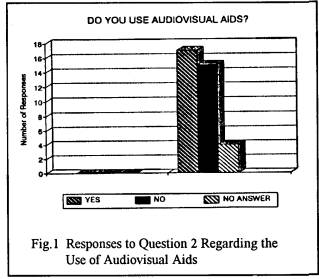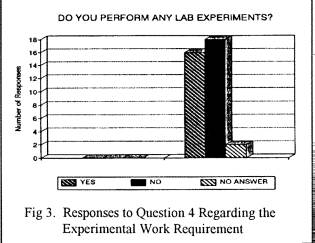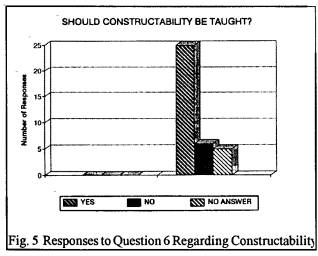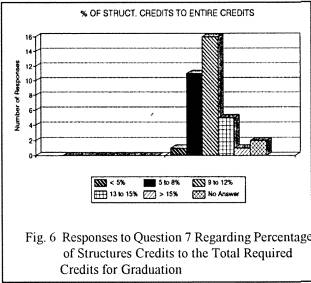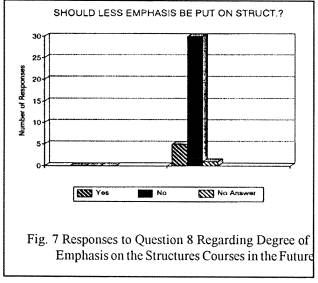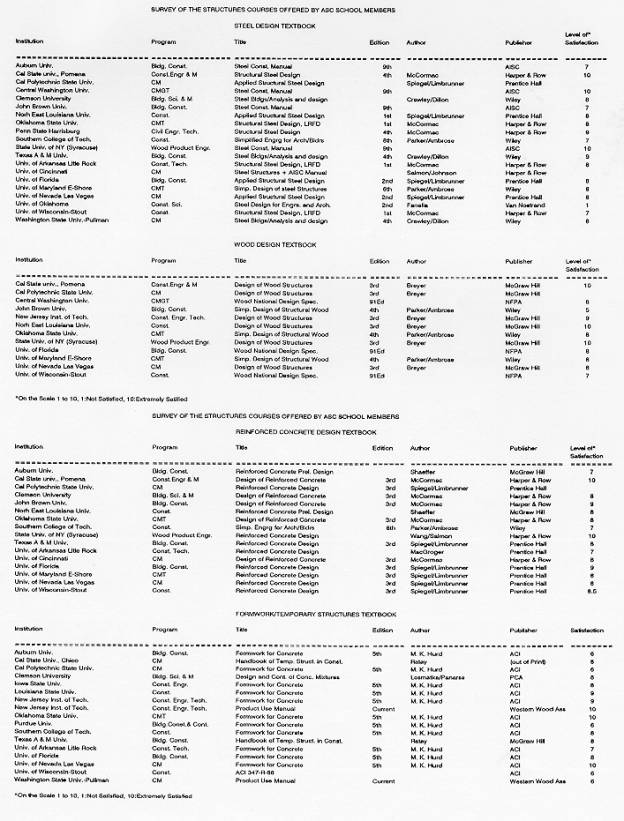|
(pressing HOME will start a new search)
|
|
Survey of the Structures Courses Offered By ASC School Members
S.
Abdol Chini
M.E.
Rinker Sr. School of Building Construction University of Florida
Gainesville,
Florida
|
A
survey of the ASC school members was conducted to develop a resource
data of textbooks, audiovisual aids, computer software and laboratory
experiments for Structures courses. The survey requested additional
information about course content, teaching methodology and number of
hours of coursework that should be devoted to Structures. The results of
the survey are presented here Keywords:
Structures, Survey,
Curriculum, Course Content, Teaching Methodology. |
Introduction
One
of the functions of the ASC Undergraduate Education Committee is the improvement
of course content through the exchange of ideas among teachers of similar
courses and through the development of reference lists, audiovisual aids, texts
and case studies. In that regard, the committee selected Structures (design of
construction elements) as a topic for the course discussion section at the 1994
National ASC Meeting in Peoria, Illinois.
To
make the course discussion more productive, a list of the Structures courses
being offered by the ASC school members was prepared. This list was based on the
directory of the ASC undergraduate programs printed in March 1990 (see Appendix
A). A questionnaire was also prepared to provide information regarding
textbooks, audiovisual aids, laboratory experiments and other important issues
regarding Structures courses. The questionnaire was initially sent out to a
group of faculty who volunteered to help at the course discussion section at
Estes Park, Colorado. The questionnaires were then modified and along with the
Structures courses list shown in Appendix A were mailed to 90 ASC school members
in January 1994. The schools were asked to review the list to make sure the
information listed regarding their program is correct and also complete the
questionnaire and mail their responses back. In March 1994, programs not
responding to the first letter were sent a second letter requesting the same
information. A total of 36 schools completed and returned the survey.
A
summary of the results of the survey was provided to participants of the course
discussion section in Peoria, Illinois. This paper presents the complete results
of the survey and discusses the issues regarding course content and teaching
methodology for Structures.
Results
Courses
considered in the Structures category for the purpose of this survey are Statics,
Mechanics of Materials, Structural Analysis and Design, Steel Design, Wood
Design, Reinforced Concrete Design, and Temporary Structures including formwork.
At the beginning, the directory of ASC undergraduate programs printed on March
15, 1990 that includes information regarding program title, degree offered,
program objectives, graduation requirements, and curriculum outline was used to
develop a list of the Structures course offered by each program. The curriculum
outline for some programs does not provide number of credits for each course, or
sometimes lists only upper division courses. Besides, in many cases the course
title does not provide information regarding its content (for example,
Structures 1, Structures 11, etc.). Therefore, the list was sent to ASC school
members for necessary corrections and completion. The list shown in Appendix A
is the revised list based on the responses received from 36 schools.
The
questionnaire included eight questions and a section for additional comments.
The first four questions were dealing with information about textbooks,
audiovisual aids, computer software, and laboratory experiments. Questions 5 and
6 were designed to seek input on course content, whereas, questions 7 and 8
aimed at finding how much design is needed by a manager. Responses to each
question are provided here.
Question
1.
"Please
list and evaluate the textbooks you are using for Structures courses."
The
Structures courses listed in this question were Statics, Strength of Materials,
Structural Analysis and Design, Steel Design, Reinforced Concrete Design, Wood
Design and Temporary Structures (including formwork). In addition to the tide,
edition, author and publisher, the respondents were requested to provide the
level of satisfaction with the textbook on the scale I to 10 (1: Not satisfied,
10: Extremely satisfied). Appendix B shows the list of the textbooks being used
for Structures courses by the schools responded to the survey.
Question
2.
"Do
you use videotapes (or any other audiovisual aids) in teaching Structures
courses? If yes, what benefit(s) do you find with this medium? Also, please
provide the list of visual aids you use."
Responses
to Question 2 are shown in Figure 1. Forty seven percent of the schools
responding to the survey mentioned they use some form of visual aids to
supplement text illustrations. They use this medium as a visual summary of
topics covered and believe it serves as a good backup to lecture materials.
Also, when class time does not allow for field trips, tapes from construction
projects are helpful. Following is a list of tapes used by some of the schools:
-Today's
Structural Steel, American Institute of Steel Construction
-Fundamentals
of Reinforced and Prestressed Concrete, Portland Cement Association
-The
Linn Cove Viaduct, A Bridge in Harmony with Nature, Federal Highway
Administration
-Skyscraper
(5th hour), Films for the Humanities and Sciences, Princeton, NJ.
-Brooklyn
Bridge, PBS
-AISC
Annual Educational Tapes on Steel design
-Engineered
Wood System, Wood Product Promotional Council (Slides)
-McGraw-Hill
Series on Structural Mechanics
-Heavy
Construction Techniques, Bobbs-Merril/ MacMillan
|
|
Question
3.
"Is
computer application part of your course work? If yes, what benefit(s) do you
find with this medium? Also, please provide the list of software you use."
As
shown in Figure 2, Fifty three percent of the respondents include computer
application in their coursework. The reasons mentioned were:
-It
enhances student's ability to apply the computer to solutions of real-life
problems.
-It
helps them to identify the "variables" and generate useful tables for
analysis and design of various types of members.
-It
speeds up the routine portion of structural design related to computation of
shear and bending moments.
-It
satisfies the student desire to have hands on experience with a computer.
|
Computer
programs being used by the respondents are fisted here. Level
of Satisfaction RISA-21)
by RISA Technologies (Educational version) 7 PCSTRAN
by Joe Murray, P.O. Box 56164, Madison, Wl
53706 5 ALGOR
by ALGOR Inc. 6 PCWIN
by Portland Cement Association 5 ENERCALC
9 CONCRETE,
comes with Mccormac Text (Design of R/C) 9 LOTUS
1-2-3, Student Ed., Release 2.4, Benjamin Cummings 10 M-S-D
Shareware 10 |
|
Table
1. |
|
|
Question
4
"Is
laboratory work required in your Structures course? If yes, please identify the
type of experiments performed."
Fig.
3 shows that only forty four percent of the schools responding require some form
of experimental work. This might be due to the lack of resources and/or time.
However, a clear understanding of structural mechanics should include some hands
on experience of the behavior of structural elements and assemblies. It is also
a fact that some of the classical theorems central to the structural mechanics
are much easier to comprehend by using laboratory models. Following is the list
of experiments mentioned by the respondents:
|
|
-Tension
test of steel and aluminum
-Torsion
test of steel
-Compression
testing of concrete
-Deflection
of beams
-Impact
test
-Illustrating
buckling concept
-Member
forces in a truss
-Equilibrium
of a beam
-Construct
a model of truss out of wood, load to failure and compare actual failure load to
predicted.
-Students
pour a slab on grade (10'xl5') in groups of 4 to 6
Question
5
"Do
you think design courses at the construction programs should have different
formats from engineering programs? If yes, please identify the
differences."
Seventy
eight percent of the respondents believe that we should not be tied to the
traditional engineering formats in teaching structures to our construction
students (see Fig. 4). In their opinion, detailed design is not necessary and
the need is more to understand concepts and concerns in dealing with the whole
building system. More diverse topics should be covered with less depth, but
sufficient for basic understanding. The emphasis should be placed on the
"construction" aspects or implications of design problems. Other
differences mentioned include:
-Some
emphasis should be on field problems, i.e., forming and temporary structures.
Some emphasis on practical aspects of the design, i.e., modular sizing, economy
of keeping same size beams and columns. Main point to make: The structure you
build has been rationally designed--build it like it's designed.
-More
emphasis should be on sequencing, the complexity of system integration, and
scheduling.
-There
needs to be an emphasis on conceptual understanding versus mathematical
manipulation.
-There
should be a discussion of different systems and framing details.
-Applied
principles should be stressed that allow understanding of the role of the
engineer and the practical problem
solving related to construction manager responsibilities.
-Following
initial design sequence, cost estimate and preliminary CPM network schedule
should be prepared.
-A
little bit of learning is dangerous. Any design course in a construction program
should be to teach rigorous thinking and structural applications. Only basic
science (Statics + Strength of materials) should be shared. Engineers and
construction students should be separated for any design course.
|
|
Question
6
"Do
you think constructability should be taught with structures courses? If yes,
please provide any suggestions you may have."
The
majority of the respondents, 70% (see Fig. 5) believe that constructability
should be woven into every problem solution. This could be achieved by pointing
out practical problems encountered in the field when trying to construct
structural members under a pressure of time and cost. Field trips, guest
speakers, and case studies from forensic engineering can provide input. In each
case, alternative methods, cost and productivity should be discussed. As an
example, students in a structural steel design course should be acquainted with
costs of welded vs. bolted connections; in concrete design, the advantages of
pre-cast vs. cast-in-place, rebar design to allow the concrete to actually flow
into a column rather than a "thicket of rebar" that acts like a,
"dam".
|
|
Question
7
In
your opinion, what percentage of the total required credits for graduation
should be devoted to structures? (Example: 10 percent, i.e., 12 credits of
Structures in a program that requires 120 credits for graduation)"
Fig.
6 shows the results of the responses to this question. Forty four percent of the
respondents think about 10 percent, i.e., 12 credits of Structures in a program
that requires 120 credits for graduation, is reasonable. However, this
percentage is program dependent and construction engineering programs normally
require more structures courses than other construction programs. The average
semester credit of structures courses for the schools listed in Appendix A is
12.1 semester credits.
|
|
Question
8
"Do
you think your construction program should put less emphasis on the structures
courses in the future? Please state your reason."
There
have been some concerns by former students that much of the information
presented in structures courses had little applicability to the daily problems
faced in construction. Eighty four percent of the respondents to the
questionnaire believed that we need to keep a strong emphasis on structures, but
perhaps a different kind of emphasis which is more toward construction and less
toward engineering. Anyone managing the construction process needs a basic
understanding of the engineer's environment and the basic understanding of how a
structure behaves. There is never enough room in the curriculum for everything,
but structures is complicated enough to require in-depth instruction. Other
reasons mentioned in response to this question were:
-Contractors/CM
are becoming more legally responsible for their work.
-Graduates
have expressed their appreciation for the knowledge useful of understanding why
they do things a certain way.
-Construction
students need a strong design background so that they can talk and respond
intelligently to architects and engineers in the construction process. This also
might prevent a few building failures, particularly on a renovation project with
no design professional present.
|
|
Additional
Comments
Several
respondents had additional comments, which are presented here:
-Local
construction industry requested a new program, which all structures courses
except Statics are substituted by management courses.
-People
studying "Construction Engineering" should take more than 6 hours of
Structures. Others should go no more than basic science, and practical
application of other professions' designs.
-We
need better discipline-specific textbooks. We need to share more information
between ASC schools-specially good problems, model ideas, video clips, etc.
Why not a library of digital images of construction sites, problems, examples,
etc.
Conclusions
Anyone
managing the construction process needs a basic understanding of the engineer's
environment and the basic understanding of how a structure behaves. Constructors
must be able to address a number of technical questions at the project site
including structural issues that sometimes are not addressed by the design
professionals. Since the safety of construction workers as well as the strength
and stability of structures during the construction phase is of paramount
importance, construction managers need this knowledge.
On the issue of how much design is needed by a manager, the result of the survey showed that 10 percent of an entire curriculum (12credits in a program that requires 120 credits for graduation) seems appropriate. The survey also confined the need to move away from traditional approaches of teaching structures which involve learning specific mathematical techniques to analyze isolated building components. Rather, there should be an emphasis on conceptual understanding of the whole structural systems. The emphasis should be more toward construction and less toward engineering. In that regard, teaching methodology is the key issue. Lecture formats should be combined with other activities such as expe4mental works, field trips, audiovisual aids, and guest speakers to motivate students and make materials easier to comprehend.
There
seems to be a need for better discipline-specific textbooks and more context
based problems/solutions. A recommendation to develop a library of digital
images of construction sites, problems, examples, etc., between ASC schools
seems interesting and the Committee of Undergraduate Education should look
into that.
Acknowledgment
The
guidance and contributions made by Professors Zaijon Baha, Howard Bashford, Neil
Opfer, Kwaku Tenah, Steve Williams, and Bruce Yoakum in developing the survey
questionnaire for this study is greatly appreciated.
|
|
|
|
|
|
